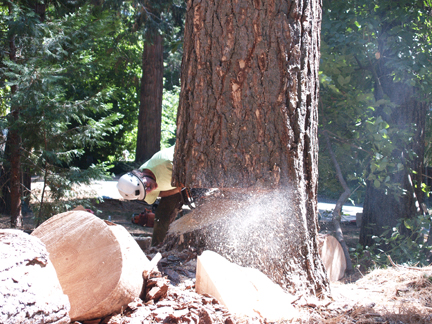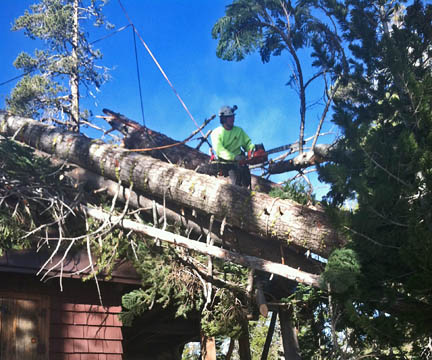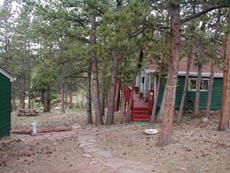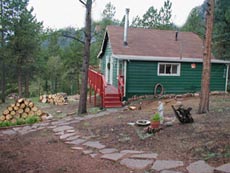| Tree Pruning Pruning is the most common tree maintenance procedure next to watering. Pruning is often desirable or necessary to remove dead, diseased, or insect-infested branches and to improve tree structure, enhance vigor, or maintain safety. Because each cut has the potential to change the growth of (or cause damage to) a tree, no branch should be removed without reason. Removing foliage from a tree has two distinct effects on its growth. Removing leaves reduces photosynthesis and may reduce overall growth. That is why pruning should always be performed sparingly. Over pruning is extremely harmful because without enough leaves, a tree cannot gather and process enough sunlight to survive. However, after pruning, the growth that does occur takes place on fewer shoots, so they tend to grow longer than they would without pruning. Understanding how the tree responds to pruning should assist you when selecting branches for removal. |
|||
 |
Tree Removal Although tree removal is a last resort, there are circumstances when it is necessary. We can help decide whether or not a tree should be removed. As professionally trained arborists, we have the skills and equipment to safely and efficiently remove trees. Removal is recommended when a tree • is dead, dying, or considered irreparably hazardous • is causing an obstruction or is crowding and causing harm to other trees and the situation is impossible to correct through pruning • is to be replaced by a more suitable specimen • should be removed to allow for construction With proper maintenance, trees are attractive and can add considerable value to your property. Poorly maintained trees, on the other hand, can be a significant liability. Pruning or removing trees, especially large trees, can be dangerous work. It should be performed only by those trained and equipped to work safely in trees. |
||
| Stump Grinding After time stumps decay, leaving unstable ground, equaling an unsafe area. Is is best to have them ground out to avoid this and the possibility of certain species of trees resprouting. |
|||
| Chipping Chipping promotes a more eco friendly approach to disposing of brush rather than burning. You can also reuse your woodchips around your trees and foliage to help keep moisture in the soil. |
|||
| Forest Fuel Reduction Though wildland fires play an integral role in many forest and range land ecosystems, decades of efforts directed at extinguishing every fire that burned has disrupted the natural fire regimes that once existed. Wildland fires also pose increasing threats to people and their property as communities develop in the wildland/urban interface (WUI) – areas where structures and other human development meet or intermingle with undeveloped wildland or with vegetative fuels. Therefore it is imperative to reduce the accumulated fuel load of brush, downed trees and standing dead trees. It is also important to recognize the delicate balance of a healthy forest ecosystem and leave an adequate number of standing dead trees (SNAGS) for cavity dwelling birds and animals as well as maintaining a proper layer of leaf litter and debris to ensure root zone protection and soil erosion prevention we can help you attain this healthy balance on your property. |
|||
Before
After |
Defensible Space Your first defense against wildfire is to create and maintain a defensible space around your home. This does not mean your landscape must be barren. Defensible space is the area around a home or other structure where fuels and vegetation are treated, cleared or reduced to slow the spread of wildfire. Creating wildfire-defensible zones also reduces the chance of a structure fire spreading to neighboring homes or the surrounding forest. Defensible space also provides room for firefighters to do their jobs when fighting wildfire. Your house is more likely to withstand a wildfire if grasses, brush, trees and other common forest fuels are managed to reduce a fire’s intensity. The following are a few key steps we can help with to creating a defensible zone. Remove unhealthy vegetation. Trees and shrubs that are stressed, diseased, dead or dying should be removed so that they do not become a fuel source for potential fires. • Create defensible space at a minimum of 100 feet around a home. Increase this distance if the structure is located on a slope. • Thin out continuous tree and brush (shrub) cover around structures. Remove flammable vegetation from within the initial 15 feet around structures. • Beyond the initial 15-30 feet, thin trees to achieve a 10-foot crown spacing. Occasionally, clumps of two or three trees are acceptable for a more natural appearance, if additional space surrounds them. Prune tree branches within the defensible space up to a height of 10 feet above ground. • Dispose of all slash and debris left from thinning by chipping, hauling away or piling for burning later. Remove shrubs and small trees or other potential ladder fuels from beneath large trees. Left in place, these fuels can carry a ground fire into tree crowns. • Trim any branches extending over roofs, and remove branches within 10 feet of chimneys. |
||
 |
Emergency Tree Care Storms may cause limbs or entire trees to fall, often landing on other trees, homes and other structures, or cars. The weight of storm-damaged trees is great, and they can be dangerous to remove or trim. We can perform the job in a safe manner, while reducing further risk of damage to property. |
||
| Logging We strive for minimal impact on your land and achieve this with precision felling and proper equipment As we enter another abnormally dry year our Conifers, particularly the Ponderosa Pines are at a greater risk of being attacked by bark beetles. In the unfortunate event this happens to your trees, sometimes logging can help defray the costs of removing, large quantities of dead and dying trees from your property. |
|||
Click here to request a FREE ESTIMATE from our Certified ArboristsCopyright Carsten Tree Service 2017, All Rights Reserved |
|||



